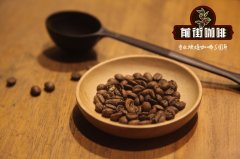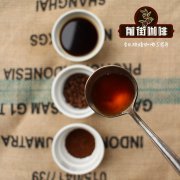Coffee varieties | the rise of hybrid coffee varieties what kind of coffee is F1?

Before introducing mixed coffee, let's briefly introduce the types and types of coffee. There are 125 kinds of coffee. But almost all coffee served in coffee shops or sold in supermarkets is Arabica coffee, robusta coffee or a mixture of both.
Arabica coffee is the most common species, famous for its high-quality flavor and aroma, but it is also the most vulnerable to diseases and pests. Robusta, on the other hand, is much less delicious, but robust. It also contains more caffeine. However, it is generally thought to be more bitter than Arabica coffee.
Arabica coffee dominates the specialty coffee industry. This species can also be divided into different flavors, with different flavors, hardness, yield and ideal growth environment.
Variety and Diversity of Coffee
Arabica coffee lacks diversity-this is a problem.
Different varieties of the species should increase genetic variability. But in fact, it has a worrying genetic similarity of 98.8%. To sum up, the similarity of crops such as rice and soybeans is only 70-80%. This makes Arabica coffee more vulnerable.
If a pile of leaf rust can affect a particular variety, it is likely to affect other similar varieties. Therefore, many coffee varieties that are resistant to coffee rust are Catimors. These are crosses between the Arabica variety Kaddura and Timor, which itself is the Arabica-Robusta hybrid. Robusta enhances hardness, diversity and rust resistance. However, it also means that buyers of specialty coffee may be vigilant about the quality of these varieties.
Coupled with the impact of climate change, if no action is taken, we may witness the slow pace of the Arabica mass extinction.
Why does Arabica coffee lack diversity?
Ethiopia is the birthplace of coffee, with the largest variety of Arabica coffee. In fact, last year, Kew Gardens determined that the country had 95 per cent of the genetic resources for coffee.
Many of these species grow wild in Ethiopian forests. If you see an Ethiopian heirloom on a bag of coffee, it may mean that it has grown in the wild or in a garden with a low planting rate.
You will also find cultivated local varieties, such as the exquisite and highly respected Gesha / Geisha, which originally came from Ethiopia but are now world-famous in Panama.
However, most Arabica coffee varieties are iron pickups, bourbon or their descendants.
Can F1 provide a solution?
Traditional Arabica varieties are either the product of lucky and naturally occurring mutations or carefully planned by humans in an agricultural environment (also known as "cultivated varieties").
However, considering that current varieties (whether cultivated or not) lack diversity and are usually prone to rust, attention has been turned to F1 hybrids. These are the varieties that breed in large numbers in the laboratory. Researchers have the ability to cross a variety of coffee varieties to create the required quality.
I asked Dr. Jos é Campos, Senior International adviser and Chairman of the Board of Directors of the International Centre for Tropical Forest Research (CIFOR), to ask the former Director-General of the Centre for Tropical Coffee Research and higher Education (CATIE). . "the results can be created in a short period of time and can only be achieved through asexual reproduction," he told me.
Hybridization is an effective way to improve yield, quality and appearance. [hybrids] can provide support to areas that suffer from drought or frequent rainfall. "
William Solano, an expert on genetic resources and agricultural biodiversity at CATIE, added that F1 hybrids are generally stronger and healthier than naturally bred hybrids. Although natural varieties are not required to have the same level of diversity as F1 hybrids, so they have the same tenacity, but it is less likely. This enables F1 hybrids to survive under adverse environmental conditions, William said.
Can we design the perfect variety of coffee?
The idea of an "engineered" perfect plant is misleading: researchers can't imagine a hybrid and then create it. But what they can do is hybrid plants with traits that want to have a new variety.
Solano told me that research centers, including CATIE and World Coffee Research (WCR), have collaborated on genetic improvement programs. The aim is to expand the genetic base of Arabica. The method is to cross the wild coffee ingredients in the CATIE collection with commercial varieties such as Kaddura, Catuai and CR95. Remember all the wild species in Ethiopia? )
The team successfully bred 100 F1 strains. Of these, 20 are selected and replicated by biotechnology. The next stage is a 6-7-year field study to further reduce which hybrids should be brought to market. The team has been looking for high productivity, good rust resistance and high cup quality.
Recently, five of these 20 hybrids have been released in Central America. Tests are also planned in South America, Africa and parts of Asia in the near future.
So far, hybrid cars have proved to be successful. Centroamericano recently made headlines with 90.5 points in the Nicaragua Cup Super Bowl-an extraordinary achievement and hopeful about the future of F1 hybrids. Centroamericano is a cross between an Ethiopian local variety Rume Sudan and a rust-tolerant variety called T5296. In addition to the potential to produce high-quality coffee, it also has high yield and rust resistance.
Are hybrid varieties "better" than ordinary varieties?
The hybrid undoubtedly sounds like the perfect choice. Solano and Campos told me that most of these coffees are first-class coffee with disease resistance and extraordinary cup quality. Compared with many traditional varieties, the taste and aroma are pleasant. In Costa Rica, some F1 can double the productivity of widely cultivated Kaddura and Catuai.
However, the quality of coffee depends on many factors. At high altitude, the distance from the equator and the temperature affect how quickly the cherries ripen-and the slower they ripen, the better they usually taste. Soil can provide nutrients to make coffee trees healthier, so coffee beans are better: volcanic soil, for example, contains a lot of nitrogen.
And, of course, different varieties of coffee are suitable for different environments. For example, WCR recommends that you use a Centroamericano that does not exceed 1pr 5000 meters. Other varieties are also suitable for higher heights.
The sowing, harvesting and processing methods used can also ensure quality, for example, if the producer picks only ripe cherries and dries them on an elevated bed. Then, specific processing methods can highlight all aspects of the cup outline: natural or honey processing can enhance sweetness, while washing processing can lead to higher cleanliness and brightness. Some coffee and some areas may be more suitable for some methods than others.
Pedro Gomez, a barista lecturer at the National Learning Service of Colombia (SENA), reminded me that consumers will eventually decide the quality of their drinks. Not all customers have the same taste of coffee.
Coffee hybrids will not replace traditional varieties and varieties. There are many reasons why producers may choose to produce non-mixed crops on their farms, and consumer interest in coffee such as Gesha / Geisha,Bourbon and Kaddura will continue.
However, F1 hybrid varieties are an exciting development of the coffee industry, facing poor genetic diversity, climate change, coffee bean rust and other problems. You can expect them to get more attention in the future.
Important Notice :
前街咖啡 FrontStreet Coffee has moved to new addredd:
FrontStreet Coffee Address: 315,Donghua East Road,GuangZhou
Tel:020 38364473
- Prev

What is the variety of Castillo Castillo? Colombia cultivates coffee varieties.
The variety of Castillo (Castillo) coffee is controversial. On the one hand, it can resist leaf rust.
- Next

Coffee varieties | Why Columbia Coffee Research Center attaches so much importance to hybrid coffee varieties
As far as coffee producers are concerned, F1 hybrids tend to be high-quality, rust-proof and high-yielding varieties-the golden trio. However, there is only one problem: their procurement is extremely difficult and expensive. However, the Starmaya variety can provide a solution. It is still in the final stages of testing, but it turns out that this F1 can solve many problems in the coffee industry: rust, short coffee.
Related
- Detailed explanation of Jadeite planting Land in Panamanian Jadeite Manor introduction to the grading system of Jadeite competitive bidding, Red bid, Green bid and Rose Summer
- Story of Coffee planting in Brenka region of Costa Rica Stonehenge Manor anaerobic heavy honey treatment of flavor mouth
- What's on the barrel of Blue Mountain Coffee beans?
- Can American coffee also pull flowers? How to use hot American style to pull out a good-looking pattern?
- Can you make a cold extract with coffee beans? What is the right proportion for cold-extracted coffee formula?
- Indonesian PWN Gold Mandrine Coffee Origin Features Flavor How to Chong? Mandolin coffee is American.
- A brief introduction to the flavor characteristics of Brazilian yellow bourbon coffee beans
- What is the effect of different water quality on the flavor of cold-extracted coffee? What kind of water is best for brewing coffee?
- Why do you think of Rose Summer whenever you mention Panamanian coffee?
- Introduction to the characteristics of authentic blue mountain coffee bean producing areas? What is the CIB Coffee Authority in Jamaica?

